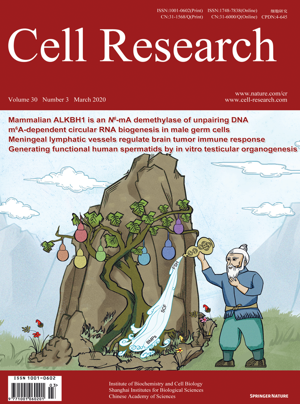
Volume 30, No 3, Mar 2020
ISSN: 1001-0602
EISSN: 1748-7838 2018
impact factor 17.848*
(Clarivate Analytics, 2019)
Volume 30 Issue 3, March 2020: 276-278
LETTERS TO THE EDITOR
Reactivation of γ-globin expression through Cas9 or base editor to treat β-hemoglobinopathies
Liren Wang1, Linxi Li1, Yanlin Ma 2,3 , Handan Hu1, Qi Li 2,3 ,Yang Yang 4, Wenbang Liu1, Shuming Yin1, Wei Li5, Bin Fu6,Ryo Kurita 7, Yukio Nakamura8, Mingyao Liu1, Yongrong Lai4 and Dali Li1
1 Shanghai Key Laboratory of Regulatory Biology, Institute of Biomedical Sciences and School of Life Sciences, East China Normal University, Shanghai 200241, China; 2Hainan Provincial Key Laboratory for human reproductive medicine and Genetic Research, Hainan Provincial Clinical Research Center for Thalassemia, The First Affiliated Hospital of Hainan Medical University, Hainan Medical University, Haikou, Hainan 570102, China; 3Key Laboratory of Tropical Translational Medicine of Ministry of Education, Hainan Medical University, Haikou, Hainan 571199, China; 4Department of Hematology, The First Affiliated Hospital of Guangxi Medical University, Nanning, Guangxi 530021, China; 5Bioray Laboratories Inc., Shanghai 200241, China; 6Department of Hematology, Xiangya Hospital, Central South University, Changsha, Hunan 410008, China;7Department of Research and Development, Central Blood Institute, Blood Service Headquarters, Japanese Red Cross Society, Tokyo 135-8521, Japan and 8Cell Engineering Division, RIKEN BioResource Center, Tsukuba, Ibaraki 305-0074, Japan
These authors contributed equally: Liren Wang, Linxi Li, Yanlin Ma,Handan Hu
Correspondence: Mingyao Liu (myliu@bio.ecnu.edu.cn) orYongrong Lai (laiyongrong@hotmail.com) or Dali Li (dlli@bio.ecnu.edu.cn)
Dear Editor,
Mutations in the β-globin gene, the essential component of adult hemoglobin (HbA; α2β2), results in either a production of aberrant sickle hemoglobin (HbS) leading to sickle cell disease (SCD) or an insufficient β-globin synthesis leading to β-thalassemia. These two major forms of β-hemoglobinopathies cause impaired erythropoiesis and life-threatening anemia. Clinical evidence has suggested that re-activation of fetal γ-globin (HBG) gene expression which is normally silenced after birth by certain genetic mutations can ameliorate the clinical course of β-hemoglobinopathies.1,2 In β-thalassemia, elevated levels of fetal γ-globin interact with α-globin to form fetal hemoglobin (HbF; α2γ2) restoring the α/β-like globin ratio and in SCD the γ-globin reduces HbS polymerization. There are two major strategies for re-activation of HBG expression: reducing the expression of critical trans-acting repression factors (such as BCL11A)3,4 or deletion of inhibitory cis-regulatory elements in the HBG1/2 promoter region. To develop a practical strategy for clinical implementation, we leveraged electroporation of a Cas9:sgRNA RNP to edit the HBG1/2 promoter in hematopoietic stem/progenitor cells (HSPCs). We successfully achieved an average editing efficiency of 85% in β-thalassemia patient-derived HSPCs, leading to increased γ-globin mRNA expression (up to 126% relative to α-globin) and an improved terminal erythroid differentiation rate. Importantly, we discovered that the BCL11A binding site (TGACCA: −114 to −119), which is critical for the repression of γ-globin,5 is an ideal target for base editor hA3A-BE3 induced mutation and elevation of HBG expression.
https://doi.org/10.1038/s41422-019-0267-z
FULL TEXT | PDF
Browse 1093


